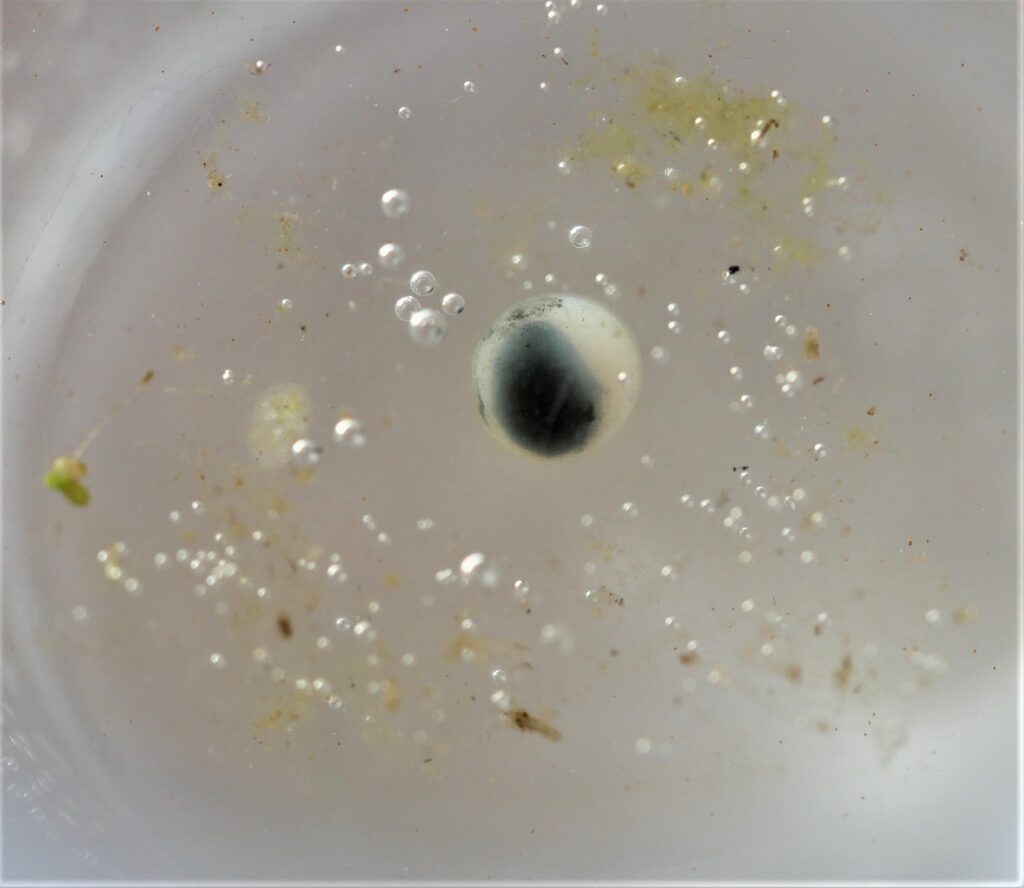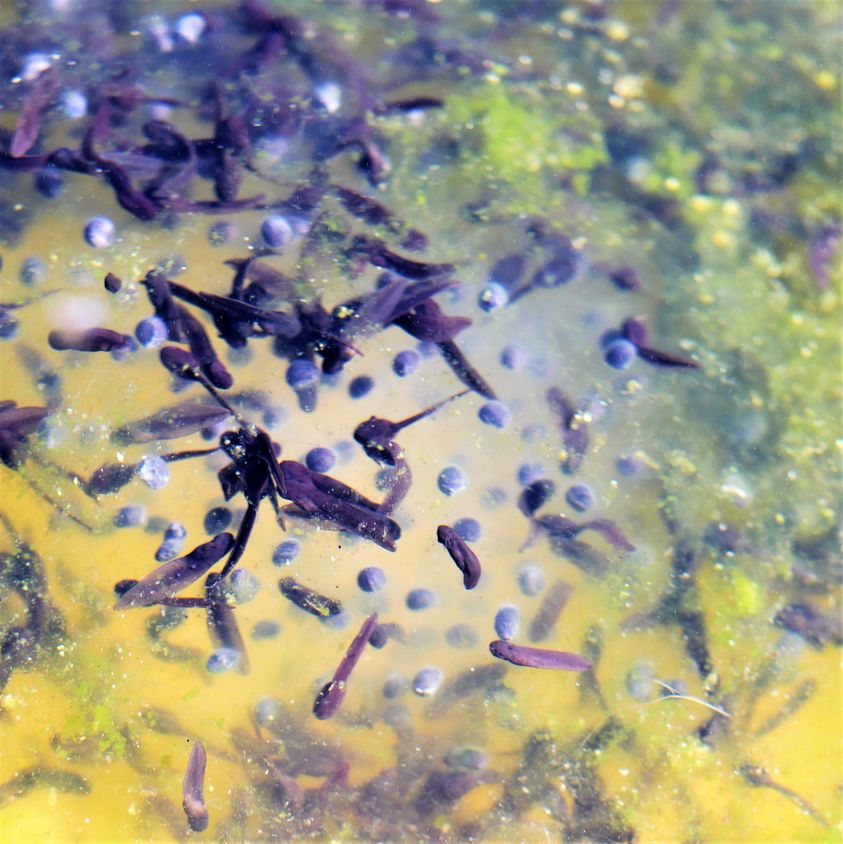By Susan Kirkup
Amphibians
Frogs and toads are classified as amphibians. The word amphibian originates from the Greek word amphibios, meaning “to live a double life.” The root of the word ‘amphi’ means “of both kinds,” and bios, means “life.” An amphibian is an animal that lives both in water and on land.
Amphibians have existed for quite some time, they were the first terrestrial vertebrate (with a back-bone) animals on our planet, evolving from jawless fish. They differ from reptiles in having smooth slimy skin, through which they can breathe, as opposed to scales. Reptiles produce shelled eggs or live young, while amphibians have a more complex life cycle with larval and adult stages.
Amphibians are extremely important animals in the wetland food chain, they are both predator, eating insects, slugs and snails, and prey, providing vital food for birds, foxes, otters and snakes. They can often be found in ponds or lakes, especially at breeding times in the early Spring and at other times in cool damp places overwintering or looking for food.
Amphibians in the UK
There are 3 types of native amphibians – frogs, toads and newts.
There are 7 species within these 3 groups.
Frogs and toads continue to grow and change as their lifestyle completely changes, but newts stay more constant.
This article looks at Common Frogs and Common Toads.
Frogs (Gaelic – Leumnachan)
There are 2 native species of frog found in the UK, the widespread common frog (Rania temporaria) and the pool frog (Pelphylax lessonae), extinct by the mid-90’s but since reintroduced in Norfolk, with no current records in Scotland.
Frogs can be found close to fresh water and in consistently damp habitats. They can roam up to 500 metres from a breeding pond site, and they are excellent jumpers with powerful hind legs.
Common Frog (Rana temporaria)

Conservation Status: Protected in the UK under the Wildlife and Countryside Act, 1981.
Length: adults males up to 9cm, females up to 13cm
Average weight: 22g
Average lifespan: 5-10 years
February to October – most active
Most active at night / early evening
Call: soft repetitive croak
ID Features
The colouration of adult common frogs is extremely variable from yellow, red, orange, pink-red, lime green, cream to black. They are able to adapt their skin colour to blend in with surrounding vegetation and have irregular dark markings on their backs. Generally they are a shade of olive-green or brown with dark patches.
The distinctive features are a slender appearance, smooth skin, long hind legs with dark bands of colour, webbed feet, and dark ‘mask ‘ behind the eye. Pupils are black surrounded by a golden iris.
Breeding
The breeding season is in early Spring, usually February/March, but can be earlier or later depending on the weather.
Frogs congregate in and around ponds with the males croaking in competition with other males to attract a female.
Female adults are larger than males, adults reach breeding age in 2-3 years. The mating behaviour or ‘amplexus’ involves males wrapping themselves around females with the help of ‘nuptial pads’ on their front feet, fertilising eggs as they are produced.
In one breeding season a female may produce up to 4000 eggs. The fertilised eggs are laid in clusters or rafts of spawn in shallow water. Click here for a video of the mating call of the common frog.


Metamorphosis & Development

The eggs are initially small black specks surrounded by a capsule of clear jelly which sustains the developing embryo until it hatches. There is no parental care and the survival rate of both eggs and hatched tadpoles is low, hence the high number of eggs produced. The eggs become a useful food source for many predators including fish, water beetles, dragonfly larvae, newts, foxes and hedgehogs.
Below is a video of a newt eating frogspawn.
In 2-4 weeks, again weather and temperature dependant , the eggs develop and tadpoles hatch. The tadpoles once again have to contend with many predators and the mortality rate is high. They feed on algae and water fleas and can take up to 14 weeks to develop into froglets.
Here’s a link to a video showing frogspawn development.
Mature tadpoles are usually speckled brown in colouration with faint speckles of gold. They undergo a huge physiological transformation during metamorphosis where the external gill structures vanish and lungs develop, and they lose their tails and grow legs.


The froglets continue to grow, leaving the water to forage for food, they reach maturity in 2-3 years. They do not strictly hibernate during the winter but rest during colder spells often in mud at the bottom of ponds or in damp places on land under log piles or compost heaps. On warmer days they venture out in search of food.


Toads
There are two native species of toad found in the UK , the widespread common toad (Bufo bufo), and the much rarer natterjack toad (Epidalea calamita) with very few confirmed records in Scotland.
Common Toad (Bufo bufo) (Gaelic – Muile-mhagaig choitcheann)

Conservation Status :
Protected in the UK under the Wildlife and Countryside Act, 1981.
Priority Species under the UK Post-2010 Biodiversity Framework
Length: Approx. 8-13cm
Weight: Up to 80g
Average lifespan: Up to 10-12 years in the wild, often misquoted as up to 50 years but this is in captivity.
February to October – most active
Call: high-pitched, rough “qwark-qwark-qwark”.
ID Features
Toads have rough warty skin which often appears dry and varies in colour from olive-brown green to greyish brown to brick-red in some adult females and immatures.
They are generally larger than frogs and have broader more flattened bodies in comparison, shorter hind legs and copper-coloured eyes.

A key identification is the prominent raised paratoid glands behind each eye in line with the snout, these glands secrete a mild toxin known as bufotoxin, rendering them unpalatable to predators.
Another feature of this species is that they walk, crawl or waddle, sometimes with short hops but are unable to jump like frogs due to their shorter hind legs.
Breeding
Common toads have a strong migratory instinct and will return year after year to ancestral breeding sites. They prefer deeper water than frogs in which to breed so not found in small garden ponds but in fish ponds, reservoirs, lochs etc.
They congregate in Spring usually later than frogs, adopting the same amplexus breeding behaviour as frogs. However rather than clumps or rafts, toad spawn is laid down in long strings, with two rows of eggs per string. The strings are usually laid around aquatic plants.

After laying down the spawn, toads leave the breeding sites and migrate away from the water. They can tolerate much drier conditions than the common frog.
Metamorphosis & Development
Development of toad eggs to tadpoles takes place within 10 to 14 days dependent on weather temperature. The emergent tadpoles are black and remain so as they develop into toadlets, growing hind legs first, then front legs with their tails disappearing last. Here’s a video showing toad spawn development.
The tadpoles also have toxins in their skin which deters predators giving them an increased chance of survival. After two or three months the toadlets leave the water to hunt for food, this can often happen in early summer when it is warm and damp after rain. With many toadlets leaving the water together and migrating further afield.
Common toads are mostly nocturnal, hunting various invertebrates for food, including ants, beetles, snails, slugs and spiders. They are fairly sedentary, if they find a good food source they will tend to stay in a particular place.
I found an opportunist toad sitting near to my moth trap in the early hours one morning no doubt having spent the night snacking at the local ‘Fly-Thru’ snack bar. Here’s the common toad mating call.

Interesting Frog and Toad Facts:
References:
Reptile and Amphibian Conservation Trust
Science Photo/ Library
Thanks to Catriona Macleod for the Gaelic names
Article By Susan Kirkup. February 2024.








